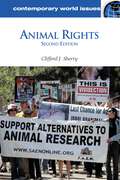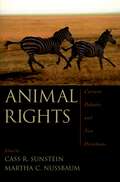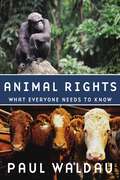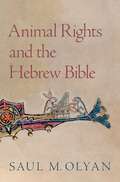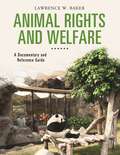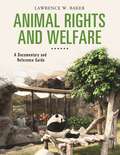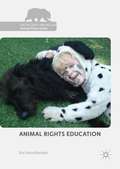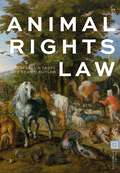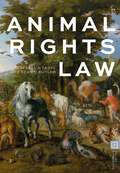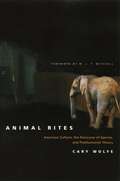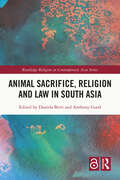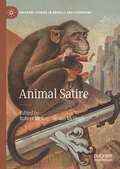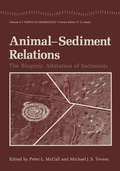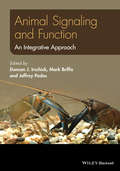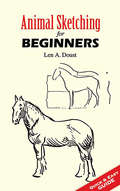- Table View
- List View
Animal Rights: A Reference Handbook (Contemporary World Issues)
by Clifford J. SherryThis revised edition helps readers understand and develop their own opinions on the fundamental issues, enduring controversies, and critical developments associated with animal rights.First published in 1994, Animal Rights: A Reference Handbook was widely acclaimed for its objective look at the ways in which humans treat animals. Extensively revised and updated, this new edition explores the basis for current perspectives on animal rights by addressing the relationship between humans and animals from scientific, philosophical, legal, and religious points of view.Animal Rights: A Reference Handbook, Second Edition maintains the balance and accessibility of the first edition, letting readers decide the bounds of human responsibility toward animals. It surveys a wide range of controversies surrounding the use of animals in such fields as the food industry, medical research, and the realm of entertainment, as well as the tremendous surge in scientific discoveries and technological advances that have led to new conversations on animal rights in the 21st century.
Animal Rights: Current Debates and New Directions
by Cass R. Sunstein Martha C. NussbaumCass Sunstein and Martha Nussbaum bring together an all-star cast of contributors to explore the legal and political issues that underlie the campaign for animal rights and the opposition to it. Addressing ethical questions about ownership, protection against unjustified suffering, and the ability of animals to make their own choices free from human control, the authors offer numerous different perspectives on animal rights and animal welfare. They show that whatever one's ultimate conclusions, the relationship between human beings and nonhuman animals is being fundamentally rethought. This book offers a state-of-the-art treatment of that rethinking.
Animal Rights: Current Debates and New Directions
by Cass R. Sunstein Martha C. NussbaumCass Sunstein and Martha Nussbaum bring together an all-star cast of contributors to explore the legal and political issues that underlie the campaign for animal rights and the opposition to it. Addressing ethical questions about ownership, protection against unjustified suffering, and the ability of animals to make their own choices free from human control, the authors offer numerous different perspectives on animal rights and animal welfare. They show that whatever one's ultimate conclusions, the relationship between human beings and nonhuman animals is being fundamentally rethought. This book offers a state-of-the-art treatment of that rethinking.
Animal Rights: What Everyone Needs to Know® (What Everyone Needs To Know®)
by Paul WaldauIn this compelling volume in the What Everyone Needs to Know® series, Paul Waldau expertly navigates the many heated debates surrounding the complex and controversial animal rights movement. Organized around a series of probing questions, this timely resource offers the most complete, even-handed survey of the animal rights movement available. The book covers the full spectrum of issues, beginning with a clear, highly instructive definition of animal rights. Waldau looks at the different concerns surrounding companion animals, wild animals, research animals, work animals, and animals used for food, provides a no-nonsense assessment of the treatment of animals, and addresses the philosophical and legal arguments that form the basis of animal rights. Along the way, readers will gain insight into the history of animal protection-as well as the political and social realities facing animals today-and become familiar with a range of hot-button topics, from animal cognition and autonomy, to attempts to balance animal cruelty versus utility. Chronicled here are many key figures and organizations responsible for moving the animal rights movement forward, as well as legislation and public policy that have been carried out around the world in the name of animal rights and animal protection. The final chapter of this indispensable volume looks ahead to the future of animal rights, and delivers an animal protection mandate for citizens, scientists, governments, and other stakeholders. With its multidisciplinary, non-ideological focus and all-inclusive coverage, Animal Rights represents the definitive survey of the animal rights movement-one that will engage every reader and student of animal rights, animal law, and environmental ethics. What Everyone Needs to Know® is a registered trademark of Oxford University Press.
Animal Rights: What Everyone Needs to Know® (What Everyone Needs To Know®)
by Paul WaldauIn this compelling volume in the What Everyone Needs to Know® series, Paul Waldau expertly navigates the many heated debates surrounding the complex and controversial animal rights movement. Organized around a series of probing questions, this timely resource offers the most complete, even-handed survey of the animal rights movement available. The book covers the full spectrum of issues, beginning with a clear, highly instructive definition of animal rights. Waldau looks at the different concerns surrounding companion animals, wild animals, research animals, work animals, and animals used for food, provides a no-nonsense assessment of the treatment of animals, and addresses the philosophical and legal arguments that form the basis of animal rights. Along the way, readers will gain insight into the history of animal protection-as well as the political and social realities facing animals today-and become familiar with a range of hot-button topics, from animal cognition and autonomy, to attempts to balance animal cruelty versus utility. Chronicled here are many key figures and organizations responsible for moving the animal rights movement forward, as well as legislation and public policy that have been carried out around the world in the name of animal rights and animal protection. The final chapter of this indispensable volume looks ahead to the future of animal rights, and delivers an animal protection mandate for citizens, scientists, governments, and other stakeholders. With its multidisciplinary, non-ideological focus and all-inclusive coverage, Animal Rights represents the definitive survey of the animal rights movement-one that will engage every reader and student of animal rights, animal law, and environmental ethics. What Everyone Needs to Know® is a registered trademark of Oxford University Press.
Animal Rights and the Hebrew Bible
by Saul M. OlyanDoes the Hebrew Bible ascribe an implicit form of legal personhood or legal rights to animals? If so, which animals--domesticated or wild, or both--receive which rights, and for what purpose? Scholars have been slow to consider these questions, and animal-oriented research as a whole, in the field of biblical studies. For the first time, author Saul M. Olyan addresses these questions in detail and explores how the evidence of the Hebrew Bible might contribute to contemporary debates about animal rights in the academy, in the courts, in the public square, and in religious communities. In this book, Olyan demonstrates that seven different biblical texts extend both legal personhood and rights to animals. The rights conferred upon them are mainly specific and situational, and the legal personhood associated them is in most cases best characterized as limited. Nonetheless, he argues that the animal rights described by these texts are genuine because they are not contingent on the needs or demands of others, they do not disappear or give way because of conflict with the interests of another legal person, and they may not be violated with impunity. Finally, Olyan considers how the biblical texts examined in his analyses might be used to extend or strengthen the arguments of those advocating for animals in judicial, academic, political, or religious settings.
Animal Rights and the Hebrew Bible
by Saul M. OlyanDoes the Hebrew Bible ascribe an implicit form of legal personhood or legal rights to animals? If so, which animals--domesticated or wild, or both--receive which rights, and for what purpose? Scholars have been slow to consider these questions, and animal-oriented research as a whole, in the field of biblical studies. For the first time, author Saul M. Olyan addresses these questions in detail and explores how the evidence of the Hebrew Bible might contribute to contemporary debates about animal rights in the academy, in the courts, in the public square, and in religious communities. In this book, Olyan demonstrates that seven different biblical texts extend both legal personhood and rights to animals. The rights conferred upon them are mainly specific and situational, and the legal personhood associated them is in most cases best characterized as limited. Nonetheless, he argues that the animal rights described by these texts are genuine because they are not contingent on the needs or demands of others, they do not disappear or give way because of conflict with the interests of another legal person, and they may not be violated with impunity. Finally, Olyan considers how the biblical texts examined in his analyses might be used to extend or strengthen the arguments of those advocating for animals in judicial, academic, political, or religious settings.
Animal Rights and Welfare: A Documentary and Reference Guide (Documentary and Reference Guides)
by Lawrence W. BakerThrough the use of primary source documents, readers can learn about key opinions and legislation in the important field of animal rights and welfare—a current and highly relevant topic.Animal Rights and Welfare: A Documentary and Reference Guide addresses a broad range of key topics within the subject of animal rights and welfare, including zoos, animal testing, philosophy regarding the treatment of animals, and practical measures instituted to protect animals, supplying readers with an impartial and authoritative resource for understanding the history of animal rights and the issues that dominate discussions about animal rights. Organized chronologically, the book discusses topics such as animal rights within the context of hunting for food, pelts, and other body parts, as well as for recreation; working animals; animals used for education or scientific and medical research; animals in the fashion and entertainment industries; and the food industry.The text provides reproductions of dozens of carefully selected primary documents from the time of Aristotle (B.C.) to present day to engage readers and provide opportunities for them to apply their critical thinking and analysis skills. The text of each document is introduced by a headnote to place it in context and concludes with analysis that details its significance and clarifies specific passages when needed. Each document or excerpt is followed by a full citation of the document.
Animal Rights and Welfare: A Documentary and Reference Guide (Documentary and Reference Guides)
by Lawrence W. BakerThrough the use of primary source documents, readers can learn about key opinions and legislation in the important field of animal rights and welfare—a current and highly relevant topic.Animal Rights and Welfare: A Documentary and Reference Guide addresses a broad range of key topics within the subject of animal rights and welfare, including zoos, animal testing, philosophy regarding the treatment of animals, and practical measures instituted to protect animals, supplying readers with an impartial and authoritative resource for understanding the history of animal rights and the issues that dominate discussions about animal rights. Organized chronologically, the book discusses topics such as animal rights within the context of hunting for food, pelts, and other body parts, as well as for recreation; working animals; animals used for education or scientific and medical research; animals in the fashion and entertainment industries; and the food industry.The text provides reproductions of dozens of carefully selected primary documents from the time of Aristotle (B.C.) to present day to engage readers and provide opportunities for them to apply their critical thinking and analysis skills. The text of each document is introduced by a headnote to place it in context and concludes with analysis that details its significance and clarifies specific passages when needed. Each document or excerpt is followed by a full citation of the document.
Animal Rights Education (The Palgrave Macmillan Animal Ethics Series)
by Kai HorsthemkeThis book explores how the ethical treatment and status of other-than-human animals influence pedagogy, teaching, and learning in general, aiming to fill what has been a gap in the philosophy of education. It examines key trends in this regard, including environmental education, humane education, posthumanist education, ecopedagogy, critical animal pedagogy, critical animal studies, animal standpoint theory, and vegan education. The book discusses animal minds and interests, and how animals have been accommodated in moral theory. Further, it investigates whether anti-racist and anti-sexist education logically entail anti-speciesist education and closes by proposing animal rights education as a viable and sound alternative, a pedagogy that does justice not only to animals in general and as species, but also to individual animals. If animal rights education is philosophically and educationally meaningful, then it can arguably offer a powerful pedagogical tool, and facilitate lasting pro-animal changes.
Animal Rights Law
by Raffael N Fasel Sean C ButlerDo animals have legal rights? This pioneering book tells readers everything they need to know about animal rights law.Using straightforward examples from over 30 legal systems from both the civil and common law traditions, and based on popular courses run by the authors at the Cambridge Centre for Animal Rights, the book takes the reader from the earliest anti-cruelty laws to modern animal welfare laws, to recent attempts to grant basic rights and personhood to animals. To help readers understand this legal evolution, it explains the ethics, legal theory, and social issues behind animal rights and connected topics such as property, subjecthood, dignity, and human rights. The book's companion website (bloomsbury.pub/animal-rights-law) provides access to briefs on the latest developments in this fast-changing area, and gives readers the tools to investigate their own legal systems with a list of key references to the latest cases, legislation, and jurisdiction-specific bibliographic references.Rich in exercises and study aids, this easy-to-use introduction is a prime resource for students from all disciplines and for anyone else who wants to understand how animals are protected by the law.
Animal Rights Law
by Raffael N Fasel Sean C ButlerDo animals have legal rights? This pioneering book tells readers everything they need to know about animal rights law.Using straightforward examples from over 30 legal systems from both the civil and common law traditions, and based on popular courses run by the authors at the Cambridge Centre for Animal Rights, the book takes the reader from the earliest anti-cruelty laws to modern animal welfare laws, to recent attempts to grant basic rights and personhood to animals. To help readers understand this legal evolution, it explains the ethics, legal theory, and social issues behind animal rights and connected topics such as property, subjecthood, dignity, and human rights. The book's companion website (bloomsbury.pub/animal-rights-law) provides access to briefs on the latest developments in this fast-changing area, and gives readers the tools to investigate their own legal systems with a list of key references to the latest cases, legislation, and jurisdiction-specific bibliographic references.Rich in exercises and study aids, this easy-to-use introduction is a prime resource for students from all disciplines and for anyone else who wants to understand how animals are protected by the law.
Animal Rites: American Culture, the Discourse of Species, and Posthumanist Theory
by Cary WolfeIn Animal Rites, Cary Wolfe examines contemporary notions of humanism and ethics by reconstructing a little known but crucial underground tradition of theorizing the animal from Wittgenstein, Cavell, and Lyotard to Lévinas, Derrida, Žižek, Maturana, and Varela. Through detailed readings of how discourses of race, sexuality, colonialism, and animality interact in twentieth-century American culture, Wolfe explores what it means, in theory and critical practice, to take seriously "the question of the animal."
Animal Rites: American Culture, the Discourse of Species, and Posthumanist Theory
by Cary WolfeIn Animal Rites, Cary Wolfe examines contemporary notions of humanism and ethics by reconstructing a little known but crucial underground tradition of theorizing the animal from Wittgenstein, Cavell, and Lyotard to Lévinas, Derrida, Žižek, Maturana, and Varela. Through detailed readings of how discourses of race, sexuality, colonialism, and animality interact in twentieth-century American culture, Wolfe explores what it means, in theory and critical practice, to take seriously "the question of the animal."
Animal Rites: American Culture, the Discourse of Species, and Posthumanist Theory
by Cary WolfeIn Animal Rites, Cary Wolfe examines contemporary notions of humanism and ethics by reconstructing a little known but crucial underground tradition of theorizing the animal from Wittgenstein, Cavell, and Lyotard to Lévinas, Derrida, Žižek, Maturana, and Varela. Through detailed readings of how discourses of race, sexuality, colonialism, and animality interact in twentieth-century American culture, Wolfe explores what it means, in theory and critical practice, to take seriously "the question of the animal."
Animal Sacrifice in the Roman Empire (31 BCE-395 CE): Power, Communication, and Cultural Transformation
by J. B. RivesFor over a thousand years, the practice of animal sacrifice held a central place in ancient Graeco-Roman culture as a means of both demonstrating piety to the gods and structuring social relationships. As Christianity took root in Rome in the third century CE, the cultural role of this practice changed dramatically. In Animal Sacrifice in the Roman Empire (31 BCE-395 CE), J. B. Rives explores the shifting socio-economic, political, and cultural significance of animal sacrifice in this crucial period of change. Drawing on literary, epigraphic, archaeological, art historical, philosophical, and scriptural evidence, this volume provides a comprehensive and detailed study of the central role of animal sacrifice in the ancient Mediterranean world and traces the changes in its social function and cultural significance during the period when that world became Christianized. By focusing on the evolution of this specific cultural practice, Rives illustrates the larger phenomenon of the religious and cultural transformation taking place in the Graeco-Roman world in the third and fourth centuries CE, providing a unique perspective which will appeal to scholars across religious and classical studies.
Animal Sacrifice in the Roman Empire (31 BCE-395 CE): Power, Communication, and Cultural Transformation
by J. B. RivesFor over a thousand years, the practice of animal sacrifice held a central place in ancient Graeco-Roman culture as a means of both demonstrating piety to the gods and structuring social relationships. As Christianity took root in Rome in the third century CE, the cultural role of this practice changed dramatically. In Animal Sacrifice in the Roman Empire (31 BCE-395 CE), J. B. Rives explores the shifting socio-economic, political, and cultural significance of animal sacrifice in this crucial period of change. Drawing on literary, epigraphic, archaeological, art historical, philosophical, and scriptural evidence, this volume provides a comprehensive and detailed study of the central role of animal sacrifice in the ancient Mediterranean world and traces the changes in its social function and cultural significance during the period when that world became Christianized. By focusing on the evolution of this specific cultural practice, Rives illustrates the larger phenomenon of the religious and cultural transformation taking place in the Graeco-Roman world in the third and fourth centuries CE, providing a unique perspective which will appeal to scholars across religious and classical studies.
Animal Sacrifice, Religion and Law in South Asia (Routledge Religion in Contemporary Asia Series)
by Daniela Berti Anthony GoodThis book presents original research on the controversies surrounding animal sacrifice in South Asia through the lens of court cases. It focuses on the parties involved in these cases: on their discourses, motivations, and contrasting points of view. Through an examination of judicial files, court decisions and newspaper articles, and interviews with protagonists, the book explores how the question of animal sacrifice is dealt with through administrative, legislative, and judicial practice. It outlines how, although animal sacrifice has over the ages been contested by various religious reform movements, the practice has remained widespread at all levels of society, especially in certain regions. It reveals that far from merely being a religious and ritual question, animal sacrifice has become a focus of broader public debate, and it discusses how the controversies highlight the contrast between ‘traditional’ and ‘reformist’ understandings of Hinduism; the conflict between the core legal and moral principles of religious freedom and social progress; and the growing concern with environmental issues and animal rights.
Animal Sacrifice, Religion and Law in South Asia (Routledge Religion in Contemporary Asia Series)
This book presents original research on the controversies surrounding animal sacrifice in South Asia through the lens of court cases. It focuses on the parties involved in these cases: on their discourses, motivations, and contrasting points of view. Through an examination of judicial files, court decisions and newspaper articles, and interviews with protagonists, the book explores how the question of animal sacrifice is dealt with through administrative, legislative, and judicial practice. It outlines how, although animal sacrifice has over the ages been contested by various religious reform movements, the practice has remained widespread at all levels of society, especially in certain regions. It reveals that far from merely being a religious and ritual question, animal sacrifice has become a focus of broader public debate, and it discusses how the controversies highlight the contrast between ‘traditional’ and ‘reformist’ understandings of Hinduism; the conflict between the core legal and moral principles of religious freedom and social progress; and the growing concern with environmental issues and animal rights.
Animal Satire (Palgrave Studies in Animals and Literature)
by Robert McKay Susan McHughAnimal Satire presents a cultural history of animal satire, a critically neglected but persistent presence in the history of cultural production, in which animals expose human folly while the strategies of satire expose the folly of human-animal relations. Highlighting the teeming animal presences across the history of satirical expression from Aristophanes to Twitter, with chapters on key works of literature, drama, film, and a plethora of satirical media, Animal Satire reveals the rich rhetorical significance of animality in powering the politics of satire from ancient and medieval through modern and contemporary times. More pressingly, the book makes the case for the significance of satire for understanding the real-world implications of rhetoric about animals in ongoing struggles for justice. By gathering both critical and creative examples from representative media forms, historical periods, and continents, this volume aims to enrich scholarship on the history of satire as well as empower creative practitioners with ideas about its practical applications today.
Animal-Sediment Relations: The Biogenic Alteration of Sediments (Topics in Geobiology #100)
by Peter L. McCallAnimal Signaling and Function: An Integrative Approach
by Duncan J. Irschick Mark Briffa Jeffrey PodosThe diversity of animal signals has been widely documented, and the generality of animal signals also tantalizingly suggests that there are common mechanisms that have selected for their origin. However, while much progress has been made on some fronts, we still lack a general theory about why the diversity of signaling structures exist. Our compilation will directly address this gap by focusing on an exciting new arena of sexual selection, namely using functional approaches to understand signaling. This approach is rooted in the idea that many signals are designed to transmit important functional imformation that is both important for issues of male quality (and hence male competition), and female choice. The increasing use of technology in sexual selection studies has enabled researchers to test whether signaling is either constrained by, or accurately transmits information about functional capacities. Further, in animals that fight vigorously, functional capacities such as endurance or strength may make the difference between winning and losing. This volume brings together a diverse collection of researchers who are actively investigating how function and signaling are related. These researchers use both a variety of methods and taxa to study animal signaling, and we believe that this integrative view is important to open up fresh vistas for why animal signals have evolved.
Animal Signaling and Function: An Integrative Approach
by Duncan J. Irschick Mark Briffa Jeffrey PodosThe diversity of animal signals has been widely documented, and the generality of animal signals also tantalizingly suggests that there are common mechanisms that have selected for their origin. However, while much progress has been made on some fronts, we still lack a general theory about why the diversity of signaling structures exist. Our compilation will directly address this gap by focusing on an exciting new arena of sexual selection, namely using functional approaches to understand signaling. This approach is rooted in the idea that many signals are designed to transmit important functional imformation that is both important for issues of male quality (and hence male competition), and female choice. The increasing use of technology in sexual selection studies has enabled researchers to test whether signaling is either constrained by, or accurately transmits information about functional capacities. Further, in animals that fight vigorously, functional capacities such as endurance or strength may make the difference between winning and losing. This volume brings together a diverse collection of researchers who are actively investigating how function and signaling are related. These researchers use both a variety of methods and taxa to study animal signaling, and we believe that this integrative view is important to open up fresh vistas for why animal signals have evolved.
Animal Sketching for Beginners
by Len A. DoustThis handy manual provides the confidence, insight, and guidance to help any sketcher create realistic animal drawings. With the help of the author's thirty-one clearly detailed drawings, this basic how-to-guide:* illustrates major attributes shared by many animals* shows how simple shapes can create complex drawings* functions as a valuable anatomy referenceA source of inspiration for artists at all levels, this book will be especially helpful to beginning art students.
